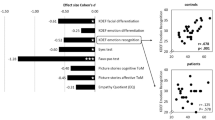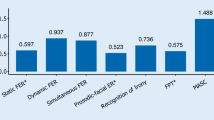Abstract
Social cognition refers to a wide cluster of sociocognitive and socioaffective processes, optimal integration of which allows individuals to efficiently navigate the surrounding, and often fast-changing, social environment. In the neurology literature, it is well known that social cognition impairments have dramatic effects on social adaptability in the context of sudden and neurodevelopmental conditions as well. This is the reason why mapping and preserving social cognition in glioma patients have progressively become an important concern with the aim to give the patients the best opportunities to resume a normal personal and socio-professional life after surgery. In this chapter, after defining social cognition and characterizing its underlying neural networks, the tasks typically used to map and monitor specific aspects of social cognition in the operating theater will be thoroughly described. Next will be reviewed studies showing how beneficial is this intraoperative mapping for the patients’ postoperative recovery. Then, we will develop on the considerable knowledge that has been gained from electrostimulation mapping procedure, especially in the context of mentalizing. Finally, we will provide some guidance on improving the intraoperative mapping of sociocognitive functions.
Access this chapter
Tax calculation will be finalised at checkout
Purchases are for personal use only
Similar content being viewed by others
References
Baron-Cohen S, Jolliffe T, Mortimore C, Robertson M. Another advanced test of theory of mind: evidence from very high functioning adults with autism or Asperger syndrome. J Child Psychol Psychiatry. 1997;38(7):813–22.
Brothers L. The social brain: a project for integrating primate behavior and neurophysiology in a new domain. Concepts Neurosci. 1990;1:27–61.
Baron-Cohen S, Ring HA, Bullmore ET, Wheelwright S, Ashwin C, Williams SC. The amygdala theory of autism. Neurosci Biobehav Rev. 2000;24(3):355–64. https://doi.org/10.1016/s0149-7634(00)00011-7.
Green MF, Horan WP, Lee J. Social cognition in schizophrenia. Nat Rev Neurosci. 2015;16(10):620–31. https://doi.org/10.1038/nrn4005.
Penn DL, Sanna LJ, Roberts DL. Social cognition in schizophrenia: an overview. Schizophr Bull. 2008;34(3):408–11. https://doi.org/10.1093/schbul/sbn014.
Adolphs R. The neurobiology of social cognition. Curr Opin Neurobiol. 2001;11(2):231–9. https://doi.org/10.1016/s0959-4388(00)00202-6.
Frith CD, Frith U. Mechanisms of social cognition. Annu Rev Psychol. 2012;63:287–313. https://doi.org/10.1146/annurev-psych-120710-100449.
Mar RA. The neural bases of social cognition and story comprehension. Annu Rev Psychol. 2011;62:103–34. https://doi.org/10.1146/annurev-psych-120709-145406.
Patterson K, Nestor PJ, Rogers TT. Where do you know what you know? The representation of semantic knowledge in the human brain. Nat Rev Neurosci. 2007;8(12):976–87. https://doi.org/10.1038/nrn2277.
Herbet G, Duffau H. Revisiting the functional anatomy of the human brain: toward a meta-networking theory of cerebral functions. Physiol Rev. 2020;100(3):1181–228. https://doi.org/10.1152/physrev.00033.2019.
Schaafsma SM, Pfaff DW, Spunt RP, Adolphs R. Deconstructing and reconstructing theory of mind. Trends Cogn Sci. 2015;19(2):65–72. https://doi.org/10.1016/j.tics.2014.11.007.
Keysers C, Gazzola V. Integrating simulation and theory of mind: from self to social cognition. Trends Cogn Sci. 2007;11(5):194–6. https://doi.org/10.1016/j.tics.2007.02.002.
Lieberman MD. Social cognitive neuroscience: a review of core processes. Annu Rev Psychol. 2007;58:259–89. https://doi.org/10.1146/annurev.psych.58.110405.085654.
Pan J, Zhan L, Hu C, Yang J, Wang C, Gu L, et al. Emotion regulation and complex brain networks: association between expressive suppression and efficiency in the fronto-parietal network and default-mode network. Front Hum Neurosci. 2018;12:70. https://doi.org/10.3389/fnhum.2018.00070.
Wang Y, Metoki A, Alm KH, Olson IR. White matter pathways and social cognition. Neurosci Biobehav Rev. 2018;90:350–70. https://doi.org/10.1016/j.neubiorev.2018.04.015.
Yang DY, Rosenblau G, Keifer C, Pelphrey KA. An integrative neural model of social perception, action observation, and theory of mind. Neurosci Biobehav Rev. 2015;51:263–75. https://doi.org/10.1016/j.neubiorev.2015.01.020.
Grill-Spector K, Weiner KS. The functional architecture of the ventral temporal cortex and its role in categorization. Nat Rev Neurosci. 2014;15(8):536–48. https://doi.org/10.1038/nrn3747.
Grill-Spector K, Weiner KS, Gomez J, Stigliani A, Natu VS. The functional neuroanatomy of face perception: from brain measurements to deep neural networks. Interface Focus. 2018;8(4):20180013. https://doi.org/10.1098/rsfs.2018.0013.
Grill-Spector K, Weiner KS, Kay K, Gomez J. The functional neuroanatomy of human face perception. Annu Rev Vis Sci. 2017;3:167–96. https://doi.org/10.1146/annurev-vision-102016-061214.
Haxby JV, Hoffman EA, Gobbini MI. Human neural systems for face recognition and social communication. Biol Psychiatry. 2002;51(1):59–67. https://doi.org/10.1016/s0006-3223(01)01330-0.
Weiner KS, Grill-Spector K. The evolution of face processing networks. Trends Cogn Sci. 2015;19(5):240–1. https://doi.org/10.1016/j.tics.2015.03.010.
Herbet G, Zemmoura I, Duffau H. Functional anatomy of the inferior longitudinal fasciculus: from historical reports to current hypotheses. Front Neuroanat. 2018;12:77. https://doi.org/10.3389/fnana.2018.00077.
Grossi D, Soricelli A, Ponari M, Salvatore E, Quarantelli M, Prinster A, et al. Structural connectivity in a single case of progressive prosopagnosia: the role of the right inferior longitudinal fasciculus. Cortex. 2014;56:111–20. https://doi.org/10.1016/j.cortex.2012.09.010.
Thomas C, Avidan G, Humphreys K, Jung KJ, Gao F, Behrmann M. Reduced structural connectivity in ventral visual cortex in congenital prosopagnosia. Nat Neurosci. 2009;12(1):29–31. https://doi.org/10.1038/nn.2224.
Rizzolatti G, Craighero L. The mirror-neuron system. Annu Rev Neurosci. 2004;27:169–92. https://doi.org/10.1146/annurev.neuro.27.070203.144230.
Rizzolatti G, Sinigaglia C. The functional role of the parieto-frontal mirror circuit: interpretations and misinterpretations. Nat Rev Neurosci. 2010;11(4):264–74. https://doi.org/10.1038/nrn2805.
Grossman ED, Battelli L, Pascual-Leone A. Repetitive TMS over posterior STS disrupts perception of biological motion. Vis Res. 2005;45(22):2847–53. https://doi.org/10.1016/j.visres.2005.05.027.
Thompson J, Parasuraman R. Attention, biological motion, and action recognition. Neuroimage. 2012;59(1):4–13. https://doi.org/10.1016/j.neuroimage.2011.05.044.
Bonini L. The extended mirror neuron network: anatomy, origin, and functions. Neuroscientist. 2017;23(1):56–67. https://doi.org/10.1177/1073858415626400.
Bufalari I, Aprile T, Avenanti A, Di Russo F, Aglioti SM. Empathy for pain and touch in the human somatosensory cortex. Cereb Cortex. 2007;17(11):2553–61. https://doi.org/10.1093/cercor/bhl161.
Singer T, Critchley HD, Preuschoff K. A common role of insula in feelings, empathy and uncertainty. Trends Cogn Sci. 2009;13(8):334–40. https://doi.org/10.1016/j.tics.2009.05.001.
Singer T, Frith C. The painful side of empathy. Nat Neurosci. 2005;8(7):845–6. https://doi.org/10.1038/nn0705-845.
Iacoboni M, Dapretto M. The mirror neuron system and the consequences of its dysfunction. Nat Rev Neurosci. 2006;7(12):942–51. https://doi.org/10.1038/nrn2024.
Premack D, Woodruff G. Does a chimpanzee have a theory of mind. Behav Brain Sci. 1978;1(4):515–26. https://doi.org/10.1017/S0140525X00076512.
Amodio DM, Frith CD. Meeting of minds: the medial frontal cortex and social cognition. Nat Rev Neurosci. 2006;7(4):268–77. https://doi.org/10.1038/nrn1884.
Carrington SJ, Bailey AJ. Are there theory of mind regions in the brain? A review of the neuroimaging literature. Hum Brain Mapp. 2009;30(8):2313–35. https://doi.org/10.1002/hbm.20671.
Schurz M, Radua J, Aichhorn M, Richlan F, Perner J. Fractionating theory of mind: a meta-analysis of functional brain imaging studies. Neurosci Biobehav Rev. 2014;42:9–34. https://doi.org/10.1016/j.neubiorev.2014.01.009.
Frith U, Frith CD. Development and neurophysiology of mentalizing. Philos Trans R Soc Lond Ser B Biol Sci. 2003;358(1431):459–73. https://doi.org/10.1098/rstb.2002.1218.
Van Overwalle F, Baetens K. Understanding others’ actions and goals by mirror and mentalizing systems: a meta-analysis. Neuroimage. 2009;48(3):564–84. https://doi.org/10.1016/j.neuroimage.2009.06.009.
Grosse Wiesmann C, Schreiber J, Singer T, Steinbeis N, Friederici AD. White matter maturation is associated with the emergence of Theory of Mind in early childhood. Nat Commun. 2017;8:14692. https://doi.org/10.1038/ncomms14692.
Herbet G, Lafargue G, de Champfleur NM, Moritz-Gasser S, le Bars E, Bonnetblanc F, et al. Disrupting posterior cingulate connectivity disconnects consciousness from the external environment. Neuropsychologia. 2014b;56:239–44. https://doi.org/10.1016/j.neuropsychologia.2014.01.020.
Herbet G, Lafargue G, Moritz-Gasser S, Menjot de Champfleur N, Costi E, Bonnetblanc F, et al. A disconnection account of subjective empathy impairments in diffuse low-grade glioma patients. Neuropsychologia. 2015b;70:165–76. https://doi.org/10.1016/j.neuropsychologia.2015.02.015.
Nakajima R, Yordanova YN, Duffau H, Herbet G. Neuropsychological evidence for the crucial role of the right arcuate fasciculus in the face-based mentalizing network: a disconnection analysis. Neuropsychologia. 2018b;115:179–87. https://doi.org/10.1016/j.neuropsychologia.2018.01.024.
Wang Y, Olson IR. The original social network: white matter and social cognition. Trends Cogn Sci. 2018;22(6):504–16. https://doi.org/10.1016/j.tics.2018.03.005.
Yordanova YN, Duffau H, Herbet G. Neural pathways subserving face-based mentalizing. Brain Struct Funct. 2017;222(7):3087–105. https://doi.org/10.1007/s00429-017-1388-0.
Pertz M, Okoniewski A, Schlegel U, Thoma P. Impairment of sociocognitive functions in patients with brain tumours. Neurosci Biobehav Rev. 2020;108:370–92. https://doi.org/10.1016/j.neubiorev.2019.11.018.
Campanella F, Fabbro F, Ius T, Shallice T, Skrap M. Acute effects of surgery on emotion and personality of brain tumor patients: surgery impact, histological aspects, and recovery. Neuro Oncol. 2015;17(8):1121–31. https://doi.org/10.1093/neuonc/nov065.
Goebel S, Mehdorn HM, Wiesner CD. Social cognition in patients with intracranial tumors: do we forget something in the routine neuropsychological examination? J Neurooncol. 2018;140(3):687–96. https://doi.org/10.1007/s11060-018-3000-8.
Herbet G, Lafargue G, Bonnetblanc F, Moritz-Gasser S, Duffau H. Is the right frontal cortex really crucial in the mentalizing network? A longitudinal study in patients with a slow-growing lesion. Cortex. 2013;49(10):2711–27. https://doi.org/10.1016/j.cortex.2013.08.003.
Herbet G, Lafargue G, Moritz-Gasser S, Bonnetblanc F, Duffau H. Interfering with the neural activity of mirror-related frontal areas impairs mentalistic inferences. Brain Struct Funct. 2015a;220(4):2159–69. https://doi.org/10.1007/s00429-014-0777-x.
Nakajima R, Kinoshita M, Okita H, Yahata T, Matsui M, Nakada M. Neural networks mediating high-level mentalizing in patients with right cerebral hemispheric gliomas. Front Behav Neurosci. 2018a;12:33. https://doi.org/10.3389/fnbeh.2018.00033.
Herbet G, Lafargue G, Bonnetblanc F, Moritz-Gasser S, Menjot de Champfleur N, Duffau H. Inferring a dual-stream model of mentalizing from associative white matter fibres disconnection. Brain. 2014a;137(Pt 3):944–59. https://doi.org/10.1093/brain/awt370.
Abu-Akel A, Shamay-Tsoory S. Neuroanatomical and neurochemical bases of theory of mind. Neuropsychologia. 2011;49(11):2971–84.
Bates E, Wilson SM, Saygin AP, Dick F, Sereno MI, Knight RT, et al. Voxel-based lesion-symptom mapping. Nat Neurosci. 2003;6(5):448–50. https://doi.org/10.1038/nn1050.
Thiebaut de Schotten M, Urbanski M, Valabregue R, Bayle DJ, Volle E. Subdivision of the occipital lobes: an anatomical and functional MRI connectivity study. Cortex. 2014;56:121–37. https://doi.org/10.1016/j.cortex.2012.12.007.
Baron-Cohen S, Wheelwright S. The empathy quotient: an investigation of adults with Asperger syndrome or high functioning autism, and normal sex differences. J Autism Dev Disord. 2004;34(2):163–75. https://doi.org/10.1023/b:jadd.0000022607.19833.00.
Lawrence EJ, Shaw P, Baker D, Baron-Cohen S, David AS. Measuring empathy: reliability and validity of the Empathy Quotient. Psychol Med. 2004;34(5):911–9.
Campanella F, Shallice T, Ius T, Fabbro F, Skrap M. Impact of brain tumour location on emotion and personality: a voxel-based lesion-symptom mapping study on mentalization processes. Brain. 2014;137(Pt 9):2532–45. https://doi.org/10.1093/brain/awu183.
Giussani C, Pirillo D, Roux FE. Mirror of the soul: a cortical stimulation study on recognition of facial emotions. J Neurosurg. 2010;112(3):520–7. https://doi.org/10.3171/2009.5.JNS081522.
Papagno C, Pisoni A, Mattavelli G, Casarotti A, Comi A, Fumagalli F, et al. Specific disgust processing in the left insula: new evidence from direct electrical stimulation. Neuropsychologia. 2016;84:29–35. https://doi.org/10.1016/j.neuropsychologia.2016.01.036.
Mandonnet E, Herbet G, Duffau H. Letter: introducing new tasks for intraoperative mapping in awake glioma surgery: clearing the line between patient care and scientific research. Neurosurgery. 2020;86(2):E256–7. https://doi.org/10.1093/neuros/nyz447.
Herbet G, Maheu M, Costi E, Lafargue G, Duffau H. Mapping neuroplastic potential in brain-damaged patients. Brain. 2016;139(Pt 3):829–44. https://doi.org/10.1093/brain/awv394.
Yordanova YN, Cochereau J, Duffau H, Herbet G. Combining resting state functional MRI with intraoperative cortical stimulation to map the mentalizing network. Neuroimage. 2019;186:628–36. https://doi.org/10.1016/j.neuroimage.2018.11.046.
Baron-Cohen S, Wheelwright S, Hill J, Raste Y, Plumb I. The “Reading the Mind in the Eyes” Test revised version: a study with normal adults, and adults with Asperger syndrome or high-functioning autism. J Child Psychol Psychiatry. 2001;42(2):241–51.
Nakajima R, Kinoshita M, Okita H, Yahata T, Nakada M. Glioma surgery under awake condition can lead to good independence and functional outcome excluding deep sensation and visuospatial cognition. Neurooncol Pract. 2019;6(5):354–63. https://doi.org/10.1093/nop/npy054.
Duffau H. Stimulation mapping of white matter tracts to study brain functional connectivity. Nat Rev Neurol. 2015;11(5):255–65. https://doi.org/10.1038/nrneurol.2015.51.
Cochereau J, Deverdun J, Herbet G, Charroud C, Boyer A, Moritz-Gasser S, et al. Comparison between resting state fMRI networks and responsive cortical stimulations in glioma patients. Hum Brain Mapp. 2016;37(11):3721–32. https://doi.org/10.1002/hbm.23270.
Rojkova K, Volle E, Urbanski M, Humbert F, Dell’Acqua F, Thiebaut de Schotten M. Atlasing the frontal lobe connections and their variability due to age and education: a spherical deconvolution tractography study. Brain Struct Funct. 2016;221(3):1751–66. https://doi.org/10.1007/s00429-015-1001-3.
Mandonnet E, Herbet G, Moritz-Gasser S, Poisson I, Rheault F, Duffau H. Electrically induced verbal perseveration: a striatal deafferentation model. Neurology. 2019;92(6):e613–21. https://doi.org/10.1212/WNL.0000000000006880.
Almairac F, Herbet G, Moritz-Gasser S, de Champfleur NM, Duffau H. The left inferior fronto-occipital fasciculus subserves language semantics: a multilevel lesion study. Brain Struct Funct. 2015;220(4):1983–95. https://doi.org/10.1007/s00429-014-0773-1.
Schilbach L, Timmermans B, Reddy V, Costall A, Bente G, Schlicht T, et al. Toward a second-person neuroscience. Behav Brain Sci. 2013;36(4):393–414. https://doi.org/10.1017/S0140525X12000660.
Adolphs R. Recognizing emotion from facial expressions: psychological and neurological mechanisms. Behav Cogn Neurosci Rev. 2002;1(1):21–62. https://doi.org/10.1177/1534582302001001003.
Nakada M. The handbook of awake surgery. Tokyo: Chugai-igaku; 2019.
Author information
Authors and Affiliations
Corresponding author
Editor information
Editors and Affiliations
Rights and permissions
Copyright information
© 2021 Springer Nature Switzerland AG
About this chapter
Cite this chapter
Nakajima, R., Kinoshita, M., Nakada, M., Herbet, G. (2021). Social Cognition. In: Mandonnet, E., Herbet, G. (eds) Intraoperative Mapping of Cognitive Networks. Springer, Cham. https://doi.org/10.1007/978-3-030-75071-8_18
Download citation
DOI: https://doi.org/10.1007/978-3-030-75071-8_18
Published:
Publisher Name: Springer, Cham
Print ISBN: 978-3-030-75070-1
Online ISBN: 978-3-030-75071-8
eBook Packages: Biomedical and Life SciencesBiomedical and Life Sciences (R0)




